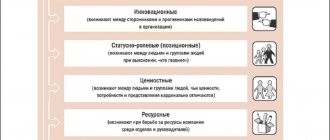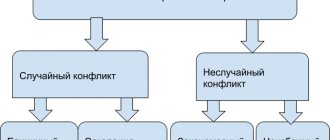Business conflict, what is it?
Conflicts are an unchanging part of human existence.
They are not only a destructive link in social interaction, but also a productive one, since they can push people to develop, improve communication skills and emotional intelligence in general.
Conflict , an extreme way to resolve contradictions that have arisen between the parties. In turn, each party to the conflict has goals, interests and motives that they hope to realize.
In short, business conflict is a type of social conflict in which people involved in the work process conflict.
In 80% of cases, a conflict appears in the absence of direct desires of the participants regarding its occurrence, which is due to:
- insufficient ability of participants to use their own emotional intelligence,
- inability to properly implement communication skills,
- insufficient attention to the socio-psychological characteristics of social contacts.
Business conflict. Main rules of business ethics:
Preventive actions
Every business conflict is easier and wiser to prevent and prevent than to resolve later. The following recommendations can help greatly:
- Maintain a fair company policy aimed at equal distribution of benefits for all employees.
- Creating a comfortable environment for work.
- Prescribing measures to resolve disputes.
- Avoiding emergency situations.
- Preventing the influence of personal problems on the work activities of the entire team.
When faced with a conflict situation, a person can take two different paths: try to avoid it or accept it for a constructive solution. The first path leads either to a painless resolution of the problem, or, conversely, to prolongation. The second path is active and therefore often turns out to be productive. It helps you develop your communication skills, as well as gain experience in difficult business communication.
When faced with a conflict situation, a person can take two different paths: try to avoid it or accept it for a constructive solution.
Kinds
Conflicts, depending on the position of the participants in the work hierarchy, are divided into:
- Horizontal. Such conflict situations occur between employees who are at the same level in the hierarchical system.
- Vertical. Vertical is called a conflict that occurs between participants who are at different levels of the hierarchical system. For example, vertical conflicts include a conflict between a boss and an employee or a conflict between a group of employees and the company’s management, which could be expressed in the form of strikes or mass layoffs at their own request.
Horizontal and vertical conflicts have different features and, as a rule, different methods of resolution, since the participant who is higher in the social ladder has power and can use it to more effectively influence the course of the conflict situation in an effort to get what they want.
Conflicts, depending on the number of participants, are divided into:
- Interpersonal. If a personal conflict arises between two employees of an organization (which may not even have a direct connection with work activities), it is called interpersonal.
- Intergroup. If the conflicting parties consist of several participants who can be combined into a conditional group, such a conflict is classified as intergroup. In some cases, people in these groups are united according to certain characteristics. For example, several Caucasian co-workers made rude remarks about black people, which led to racial conflict in the workplace because black co-workers heard this and were offended. Accordingly, in one conflicting group there are people with light skin, and in the other, people with dark skin.
- Personality and team. One side of the conflict is represented by a group of people, and the other by one person.
If the conflict situation is horizontal, the conflict behavior of a group of people towards an individual can be extremely cruel, since a person who does not have the power to protect him will be especially vulnerable. Such conflict situations often involve the use of bullying, boycotting, insults, various types of mental and sometimes physical violence. For example, the work team learned that one of the participants belongs to the LGBT community. If conservative, intolerant views prevail in a team, this can result in a “person-team” conflict.
Also, conflicts, depending on the degree of openness, are divided into:
- Open. No one tries to hide the presence of a conflict, so everyone around them, including their superiors, knows about it. The methods used in open conflicts are more straightforward and are expressed in the form of public quarrels and protests. In turn, the reaction of each side can also be open or hidden (ignoring the attacks of the side acting openly, refusing to enter into direct social contact). But, of course, a conflict cannot be called open if at least one side does not act directly.
- Hidden. All parties to the conflict try to hide from others that the conflict exists. The methods used in the development of a conflict situation are largely indirect, for example, boycott, ignoring the needs of one party, the desire to ensure that opponents receive the most disadvantageous position in the work process (one party can deliberately dump the most unpleasant part of the work on the other).
The essence of conflicts in business communication, their classification and causes of occurrence
Topic 8. Conflicts in the communication process
Plan:
1)The essence and classification of conflicts in business communication;
2)Stress in the organization;
3)Conflict Management.
The essence of conflicts in business communication, their classification and causes of occurrence
Business communications represent the interaction of partners, the exchange of information, the coordination of points of view and positions. People interacting are different from each other; Accordingly, they may perceive the situations in which they find themselves differently. Differences in perception often lead to people disagreeing with each other and the situation will be of a conflict nature. The manager, according to his role, is usually at the center of any conflict in the organization and is called upon to resolve it by all means available to him. Conflict management is one of the most important functions of a leader.
Conflict (from the Latin “confliktus” - “joint blow”, “clash”) is a collision of opposing goals, interests, positions, opinions or views of opponents (subjects of interaction). That is, it is a lack of agreement between two or more parties. In this case, the conscious behavior of one of the parties (an individual, a group or an organization as a whole) comes into conflict with the interests of the other party.
Under the structure of conflict
is understood as a set of stable connections between the components of the conflict that ensure its integrity, i.e. without which it cannot exist as an integral system and process (see Figure 1).
Figure 1 – Structure of the conflict
First of all, it is necessary that the parties to the conflict understand their interests, be ready for conflict actions and carry them out (i.e., there must be participants in the conflict - opponents
). In business communication, the parties to the conflict act not as individuals, but as officials; they can form groups.
Among all the participants in the conflict, the main participants ( warring parties)
)
.
The main participants seek support from other employees or superiors, who also become participants in the conflict, forming
a support group
that includes accomplices and instigators. Anyone who is looking for supporters in a conflict situation must first of all think about the consequences. It is possible that he will be forced to make concessions to his supporters, or in the future he will become so dependent on them that he will no longer rejoice at victory in the conflict.
The subject of the conflict
is what its participants are fighting for or against among themselves. This can be an objectively existing or imaginary problem: a material (resource), social (power) or spiritual (idea, norm, principle) value, the possession of which the opposing sides strive to possess.
In the struggle for possession of the subject of the conflict, its participants are guided by motives
encouraging them to enter into conflict.
The main drivers of conflict activity among participants are their needs
.
Conscious needs act as the interests
of opposing parties.
The motives of the participants are specified in their goals (i.e., the idea of the final, desired result of the conflict).
To achieve their goals, participants use certain strategies and tactics
behavior in a conflict situation, which will be discussed later.
From the point of view of the causes of the conflict situation, conflicts can be classified as follows (see Figure 2).
Figure 2 – Classification of conflicts
According to opponents' needs
conflicts are divided into:
1) conflict of goals.
In this case, the situation is characterized by the fact that the parties involved have different visions of the desired state of the object (for example, an enterprise, an organization) in the future. There are many methods for resolving such conflicts.
2)difference of opinion
, ideas and thoughts on the problem being solved. Resolving such conflicts requires more time than resolving conflicts associated with conflicting goals.
3)sensory conflict
, appearing in a situation where the participants have different feelings and emotions that underlie their relationships with each other as individuals. People simply irritate each other (people irritate each other with the style of their behavior, doing business, interacting). Such conflicts are the most difficult to resolve, since they are based on reasons related to the individual’s psyche.
4) resource conflict
– arises regarding the distribution or redistribution of resources and is aimed at satisfying material needs.
5) status-role conflict –
manifests itself in the struggle to occupy a higher status and a greater role in interpersonal relationships (its goal is to satisfy social needs).
Depending on the nature of subordination
between opponents:
1) vertical conflicts -
between a manager and a subordinate;
2) horizontal conflicts -
between employees of equal rank;
3) conflicts along the “diagonal” –
opponents are in a relationship of indirect subordination.
According to levels, conflicts are divided into:
1) intrapersonal
(most often manifests itself as a role conflict, when one person is presented with conflicting demands regarding the expected result of his work; incompatible: needs, interests, desires, feelings, values).
Example.
The head of a section or department in a department store may require that:
1) the seller was in the department all the time and provided customers with information about goods and services for choosing or trying on certain things. In this case, the manager can
2) express dissatisfaction that the seller spends all his working time on customers and pays little attention to replenishing the department with new goods. In this situation, as a rule, the seller perceives the instructions of his manager (head of section or department) as contradictory and incompatible).
Or if a person’s acquaintance works (a conflict between family sympathies and the manager’s sense of duty - he must do one thing, but is forced to do another).
2) interpersonal
(on professional, production, social and emotional grounds). It may be between the manager and his deputy (or the head of another department).
Example.
This conflict manifests itself in the struggle of managers for limited resources (vacancy, human and financial resources, the opportunity to develop and implement projects that are beneficial to them (project approval), working time, the ability to use equipment, production capacity, etc.).
3) conflict between individual and group
(occurs in cases where a particular employee refuses to comply with group requirements or accept group values).
Example.
Any employee strives for solid earnings by exceeding standards and working overtime. The group may show a distinctly negative attitude towards the “overzealousness” of such an employee due to the fact that with his activity he helps to raise the “bar” and can cause a serious increase in demands from management. In this case, the team, as a rule, tries to “keep the average bar” in order to provide more comfortable working conditions; (“Okay, you work too much, but why are we doing that?”).
Or between the group and the leader (inadequate leadership style; incompetence of the leader, other competence of specialists).
4) intergroup conflict ( may arise due to differences in the goals of the units, as well as for reasons of confrontation between the manager and the informal leader in the team, when the working group “splits” into two subgroups - supporters of the official leadership and like-minded leaders.
May be between different levels of hierarchy.
Levels of conflict are closely related. Thus, intrapersonal conflict can make an individual feel aggressive towards others and thereby cause interpersonal conflict.
Thus, the sources of conflict
there may be a shortage of resources, unequal contributions to the business, unfulfilled expectations, management orthodoxy (i.e. the tendency of the leader to firmly adhere to certain beliefs, strictly follow the rules and line of action), lack of autonomy, etc.
According to the consequences for the organization
conflicts can be:
1) functional
– if the conflict situation is under the control of management; the parties involved in the conflict usually control themselves and the situation. Such conflicts have a positive impact on the effectiveness of the organization and are beneficial for it.
In the case of these constructive (creative)
conflicts, opponents do not go beyond ethical standards, business relationships and reasonable arguments.
The resolution of such conflicts leads to the development of relationships between people and the development of the group (in accordance with the law of dialectics, which states that the struggle of opposites is the source of development). Functional conflicts, for example, can arise at meetings, councils, business disputes, etc.
2) dysfunctional
– if the situation is out of management’s control.
This is unconstructive (destructive)
conflict arises in the following cases:
- one of the parties stubbornly and rigidly insists on its position and does not want to take into account the interests of the other party;
- one of the opponents resorts to morally condemnable methods of struggle, seeks to psychologically suppress the partner, discrediting and humiliating him.
This conflict leads to a decrease in the personal satisfaction of employees, the effectiveness of group cooperation, leads to hostility in relationships, to injustice in the distribution of resources, and forces them to act against their will in favor of one of the parties.
Thus, it is necessary to distinguish between business and personal-emotional conflicts
: the first brings partners together in search of a solution to the problem; in the second, the parties treat each other with hostility, and their actions are aimed at causing as much damage as possible to the partner.
Business conflict is constructive and helps solve the problem. It is associated with disagreements affecting the most important aspects of the organization and its employees, the resolution of which takes the organization to a new level of development.
This kind of conflict is a necessary element in the activities of organizations and the only guarantee that the organization continues to develop (“All new ideas can be brought to life only through conflicts”).
Personal-emotional conflict is destructive
character and is not associated with solving a problem, but with the struggle against individuals. Conflicts of this kind develop into squabbles and lead to negative, destructive consequences both for the individuals involved in the conflict and for the organization as a whole, sharply reducing the efficiency of its employees. It is often possible to observe how a business conflict develops into a personal one.
Stress in the organization
One of the causes of conflict in business communications may be stress.
Stress is an adaptive response of people to an external situation that leads to physical, psychological and/or behavioral abnormalities in them.
Factors causing stress among employees in the organization are presented in Figure 3.
Figure 3 – Stress factors in the organization
External stress factors (outside the organization)
include:
1) changes in society caused by scientific and technological progress
(social and technological changes on an unprecedented scale have had a strong impact on people’s lifestyles, which is reflected in their work. The modern rhythm of life has led to increased stress and internal tension, as well as an increase in internal mental discomfort, since nowadays a person is involved in the hustle and bustle of high-speed traffic , urbanized life in the midst of constant movement and change, crowds of people);
2) economic and financial conditions
(many are forced to take on additional work, or a wife who has not previously worked must go to work in order to “make ends meet”). This situation reduces leisure time or time that family members spend with each other;
3) changes in the family
(a family situation, for example, a short-term crisis caused by a quarrel or illness of relatives, or a protracted tense relationship with a spouse or children, is a serious stressor for employees),
family relocation to a new place
(caused by a job transfer or promotion);
4) the employee’s belonging to one or another social class and the environment in which he is located and lives (housing conditions, lack of infrastructure in the area of residence, neighbors, level of noise or air pollution, etc.).
Organizational Stress Factors
, are given in table 1.
Table 1 – Stress factors associated with the organization
| Type of stressors | Examples |
| 1. Administration policy and strategy | - staff reduction; — competition requirements; — performance-based remuneration system; - shift work; — bureaucratic rules; — advanced technology; — personnel assessment (certification) system. |
| 2. Organizational structure | — centralization and formalization; — conflicts between line and staff personnel; — specialization; — role uncertainty and conflicts; — lack of opportunities for advancement; - an organizational culture characterized by restrictions and mistrust. |
| 3. Organizational process | - tight control; — one-way communication (top to bottom); — lack of feedback regarding the employee’s activities; — centralized decision making; — non-participation in decision-making; — a motivation system based on punishment. |
| 4. Working conditions | - crowded workplace; - noise, heat or cold; - stale air; - strong odors; — non-compliance with labor safety measures; - bad light; - physical or mental stress; — toxic chemical elements or radiation. |
To group stress factors
can be attributed:
1) lack of group cohesion
(The Hawthorne experiments showed that cohesion (or “feeling together”) is very important for employees, especially those at the bottom of the organizational ladder. If an employee is deprived of the opportunity to feel like a member of the team due to the specifics of his workplace, due to the fact that the manager does not allow or restricts this opportunity, or because other group members do not accept him into their ranks, then stress arises);
2) lack of mutual support
(there should be support from one or more members of a cohesive group. Workers feel much better if they can share their joys and sorrows with others);
3) the presence of intrapersonal, interpersonal and intragroup conflicts
(can also be influenced by the character of the individual, her individual characteristics (temperament, etc.), role conflict, role uncertainty).
As a rule, stressful situations are a consequence of fear. People are afraid of losing their livelihood, not taking the place in life that they claim, etc. Stressful situations can occur both outside the organization and within it.
A significant place in the list of fears is occupied by those related to the profession and the workplace.
Let's look at the most typical of them.
1) Fear of not being able to cope with work.
Almost everyone experiences this state, a lot of things pile up, and a person gets the feeling that he is being torn apart. There is a desire to work on all problems at the same time, and this leads to even greater confusion. He can't cope with any problem. Because of this, a person can fall into apathy, he has the feeling that he cannot do anything at all.
To prevent such situations from arising, methods such as planning working time, organizing work breaks, highlighting priority areas in the entire complex of problems, and delegating certain tasks to other employees should be more widely used.
2) Fear of making mistakes at work.
If you can understand that you really learn from mistakes, if you do not associate mistakes made in your work with the conclusion about the inability of a particular person, you can avoid various fears and depression.
3) Fear of being left out by others.
Most people have a desire to move up the career ladder. However, not everyone has this opportunity. Only one is nominated, while the others remain. Each of these “others” reacts in their own way: some experience disappointment, while others show increased activity, noticeably improve their performance, hoping that the situation can be improved. The second reaction is more preferable.
4) Fear of losing your job.
Losing your job – just the thought of it evokes the most intense feelings of fear. Removing this feeling largely depends on the leader. If a manager is dissatisfied with the work of one of his employees, he should, in a personal conversation with him, find out the reasons that are interfering with normal activities and help the person eliminate the problem.
5) Fear of losing one's own “I”.
Whatever action a person performs, he is, in essence, looking for himself. A good opportunity to find yourself and realize your importance is your own work. However, with the modern division of labor, a person almost does not see the results of his work. Thus, he loses the opportunity for identification, loses his “I”.
Stress management must be carried out both at the organizational level and at the individual level.
Stress management at the organizational level
includes the following components:
— selection and placement of personnel;
— setting specific and achievable tasks;
— design of works;
— interaction and group decision-making;
— health improvement and personal development programs for employees.
Common recommendations for preventing stress for an employee include, for example, the ability to properly manage your time, play sports, master the technique of self-hypnosis and other relaxation methods.
Examples
- Due to the worsening economic crisis, the company cannot pay employees wages on time. The patience of a group of workers is running out, and they promote the idea of going on strike within the team. Most workers pick up on this idea, and an open vertical conflict begins.
- A girl with a speech impediment, withdrawn, not interested in active communication with colleagues, and clumsy, gets a job at the company . At the same time, her personal views differ from the views of the main part of the team, and during the discussions she carefully expresses them several times, which leads to the emergence of a conflict situation. Her opponents also remind her of other “mistakes,” for example, how she accidentally spilled coffee on the documentation, accuse her of lack of initiative, and insult her appearance and peculiarities of pronunciation of words. This is an open horizontal conflict of the “personality and collective” format.
- A young man is hired as a lawyer by his boss, because he is his friend's son .
The main team does not like this, and they are wary of the new employee. Over time, a secret leaks into the team: a man killed a man at a pedestrian crossing several years ago, but thanks to his father’s finances, he did not go to prison. Few people want to directly conflict with an influential employee, but no one has positive feelings towards him, so they try in every possible way to refuse him support and help; no one wants to work with him in a team. The man quickly notices this and begins to openly express his indignation at the situation. This is an open horizontal conflict of the “individual and collective” format, in which one side acts hidden.
Types of conflicts according to their consequences
Previously, it was believed that conflict was the result of ineffective company management. However, it is now obvious that in some cases conflict situations help to achieve better results for the company.
According to possible consequences, conflicts are divided into:
- constructive – leading to the development of the company;
- destructive – causing damage to the company.
Useful to learn: How to resolve conflict at work?
If the conflict is not managed correctly, a constructive type can turn into a destructive one. A manager must be able to overcome any type of conflict before undesirable consequences arise. A developing conflict can harm not only an individual or group, but also the entire company as a whole.
Causes
The main causes of conflicts in business communication:
- Information aspects. If various information can be conveyed in a distorted, false format, or not conveyed at all, this may cause a conflict situation to arise.
- Peculiarities of assessment perception. If certain situations and tasks are given an assessment (positive, negative, neutral or some other), some team members may disagree with it and give their own assessment.
- Incompatibility. The presence of incompatibility in the team in one or more areas: psychophysiological aspect, individual psychological, socio-psychological and psychological.
- Intra-collective social hierarchy. In teams, there is often some disunity in which workers are divided into conditional groups, within which they actively communicate and interact. At the same time, interaction between groups is reluctant or practically absent for various reasons. In such systems, intergroup conflicts are quite frequent. Also, outcasts may appear in teams and become the object of attacks and insults for any reason.
- Differences and distortions in the perception of reality. Participants of one or more parties may look at reality in a negative way and perceive fairly neutral events as clearly negative and unacceptable.
- Conservativeness, lack of flexibility in views. Participants on one or more sides are unable to put themselves in the shoes of their opponents or are unwilling to do so, so their view of the situation is one-sided and categorical.
- Natural competition. In teams there is always an element of competition, during which conflicts often arise between competitive individuals or groups.
Stages of conflicts
Despite their specificity and diversity, conflicts have common stages:
- potential formation of conflicting interests, values, norms (pre-conflict stage);
- the transition of a potential conflict into a real one or the stage of the participants in the conflict realizing their true or falsely understood interests (the conflict itself);
- conflicting actions;
- Post-conflict stage.
A pre-conflict situation is an increase in tension between potential subjects of conflict caused by certain contradictions. But contradictions do not always develop into conflict. Only those contradictions that are perceived by potential subjects of conflict as incompatible lead to an aggravation of social tension.
Social tension is also not always a harbinger of conflict. This is a complex social phenomenon, the causes of which can be very different. Let us name the most characteristic reasons causing the growth of social tension:
- Real infringement of people's interests, needs and values.
- Inadequate perception of changes occurring in society or individual social communities.
- Incorrect or distorted information about certain (real or imaginary) facts or events.
Social tension is a psychological state of people, which before the outbreak of a conflict is of a latent (hidden) nature. The most characteristic manifestation of social tension during this period is group emotions. A certain level of social tension in an optimally functioning society is a natural protective and adaptive reaction of the social organism. However, exceeding the optimal level of social tension can lead to conflicts.
One of the key concepts in social conflict is also dissatisfaction. The accumulation of dissatisfaction with the existing state of affairs or the course of developments leads to an increase in social tension. In this case, there is a transformation of dissatisfaction from subjective-objective relations into subjective-subjective ones. The essence of this transformation is that the potential subject of the conflict identifies (personifies) the real (or alleged) culprits of his dissatisfaction and at the same time realizes the intractability of the current situation by ordinary means of interaction.
The pre-conflict stage can be divided into three phases of development, which are characterized by the following features in the relationship between the parties:
- The emergence of contradictions regarding a certain controversial object; growing mistrust and social tension; presentation of unilateral or mutual claims; reduction of contacts and accumulation of grievances.
- The desire to prove the legitimacy of one’s claims and accusing the enemy of unwillingness to resolve controversial issues using “fair” methods; being locked into one's own stereotypes; the emergence of prejudice and hostility in the emotional sphere.
- Destruction of interaction structures; transition from mutual accusations to threats; increase in aggressiveness; formation of an “enemy image” and a commitment to fight.
Thus, the conflict situation is gradually transformed into an open conflict. But in itself it can exist for a long time and not develop into a conflict. For a conflict to become real, an incident is necessary.
An incident is a formal occasion, an occasion for the start of a direct clash between the parties.
An incident can happen by accident, or it can be provoked by the subject (subjects) of the conflict, or be the result of the natural course of events. It happens that an incident is prepared and provoked by some third force, pursuing its own interests in a supposed “foreign” conflict.
Stage of development of the conflict. The beginning of open confrontation between the parties is the result of conflict behavior, which is understood as actions aimed at the opposing party with the aim of capturing, holding a disputed object or forcing the opponent to abandon his goals or change them.
Depending on the conflict setting and the form of behavior of the parties, the conflict acquires a logic of development. A developing conflict tends to create additional reasons for its deepening and expansion. Each new “victim” becomes an “justification” for escalating (building up) the conflict. Therefore, each conflict is unique to a certain extent.
Conflict resolution stage. The duration and intensity of the conflict depend on the goals and attitudes of the parties, resources, means and methods of fighting, reactions to environmental conflict, symbols of victory and defeat, available (and possible) ways (mechanisms) of finding consensus.
At a certain stage in the development of the conflict, the opposing sides’ ideas about the capabilities of their own and the enemy may change significantly. There comes a moment of reassessment of values, due to new relationships, the balance of power, awareness of the real situation - the impossibility of achieving goals or the exorbitant price of success. All this stimulates a change in tactics and strategies of conflict behavior. In this case, the conflicting parties begin to look for ways of reconciliation and the intensity of the struggle, as a rule, subsides. From this moment the process of ending the conflict actually begins, which does not exclude new aggravations.
At the conflict resolution stage, possible scenarios for the development of events:
- the obvious superiority of one of the parties allows it to impose its conditions for ending the conflict on the weaker opponent;
- the fight goes on until one of the parties is completely defeated;
- the struggle becomes protracted and sluggish due to lack of resources;
- the parties make mutual concessions in the conflict, having exhausted resources and without identifying a clear (potential) winner;
- the conflict can be stopped under pressure from a third force.
The social conflict will continue until real conditions for its cessation appear.
Methods for ending a conflict are aimed mainly at changing the conflict situation itself, either by influencing the participants, or by changing the characteristics of the object of the conflict.
The final stage of the conflict resolution stage involves negotiations and legal formalization of the agreements reached. In interpersonal and intergroup conflicts, the results of negotiations can take the form of oral agreements and mutual obligations of the parties. Usually one of the conditions for starting the negotiation process is a temporary truce.
Post-conflict stage. The end of direct confrontation between the parties does not always mean that the conflict is completely resolved.
The degree of satisfaction or dissatisfaction of the parties with the concluded peace agreements will largely depend on the following provisions:
- to what extent it was possible to achieve the pursued goal during the conflict and subsequent negotiations;
- what methods and methods were used to fight;
- how great are the losses of the parties (human, material, territorial);
- how great is the degree of infringement on the self-esteem of one or another party;
- whether, as a result of the conclusion of peace, it was possible to relieve the emotional tension of the parties;
- what methods were used as the basis for the negotiation process;
- to what extent it was possible to balance the interests of the parties;
- whether the compromise was imposed by one of the parties or a third force, or was the result of a mutual search for a solution to the conflict;
- what is the reaction of the surrounding social environment to the results of the conflict.
If the parties believe that the signed peace agreements infringe on their interests, then tensions will remain, and the end of the conflict may be perceived as a temporary respite. Peace concluded as a result of mutual depletion of resources is also not always able to resolve the main controversial issues. The most durable peace is one concluded on the basis of consensus, when the parties consider the conflict to be completely resolved and build their relations on the basis of trust and cooperation.
The post-conflict stage marks a new objective reality: a new balance of power, new relationships of opponents to each other and to the surrounding social environment, a new vision of existing problems and a new assessment of their strengths and capabilities.
Prerequisites for the occurrence
Conflicts usually have a foundation consisting of disagreements, differences in views, goals, motives, previous conflicts, quarrels, disputes. This foundation is called “preconditions for conflicts”.
Prerequisites are divided into:
- internal. They are associated with the subjective perception of each participant in the conflict and his psycho-emotional characteristics,
- external. These include premises that are not directly related to the subjective perception of the parties. Sometimes these are factors that cannot be fully controlled by the participants.
List of used literature
- Antsupov A.Ya., Shipilov A.I. Conflictology. – M.: UNITY-DANA, 1999. Ch. 21
- Grishina N.V. Psychology of conflict. – St. Petersburg: Peter, 2000.
- Zerkin D.P. Fundamentals of conflictology.
- Psychology and ethics of business communication: Textbook for universities / Ed. prof. V.N. Lavrinenko. – 3rd ed., revised. and additional – M.: UNITY-DANA, 2001. – 326 p.
- Psychology and ethics of business communication: Textbook for universities / Ed. prof. V.N. Lavrinenko. – 5th ed., revised. and additional – M.: UNITY-DANA, 2006.
- Conflictology / Ed. V.V. Ratnikova. – M.: UNITY, 2005.
Attention!
If you need help writing a paper, we recommend turning to professionals. More than 70,000 authors are ready to help you right now. Free adjustments and improvements. Find out the cost of your work
Free estimate
+1
Size: 23.51K
Downloads: 123
08.12.11 at 14:31 Author: alexa7062
Liked? Click on the button below. It's not difficult for you
, and we
are pleased
).
To download test papers for free at maximum speed, register or log in to the site.
Important! All submitted Tests for free downloading are intended for drawing up a plan or basis for your own scientific works.
Friends! You have a unique opportunity to help students just like you! If our site helped you find the job you need, then you certainly understand how the job you add can make the work of others easier.
Add a job
If the Test work, in your opinion, is of poor quality, or you have already seen this work, please let us know.
Resolution methods
Basic ways to resolve conflicts:
- Normative. During the discussion, the parties to the conflict build optimal rules for interaction with each other and try to comply with them in the future. If one side notices that the other is ignoring the rules, the conflict may resume.
- Negotiation room. During the discussion, the parties discuss the conflict situation, strive to find optimal solutions suitable for everyone, and seek compromises.
- Manipulative. In the process of resolving a conflict, one of the parties behaves deliberately softly, trying to get what they want with the help of careful manipulations.
- Confrontation. When resolving a conflict, the party behaves harshly, categorically defends its own point of view and offers its own way out of the conflict situation, which suits it.
Psychological mechanisms for overcoming business conflicts:
- the need for consistency in the goals, motives and interests of all parties,
- the importance of the parties’ desire for a peaceful resolution of the conflict, the desire to better understand the perception of the other side,
- the presence of trust between the parties,
- the desire to find the optimal balance between softness and harshness on the part of management.
Guide to resolving conflicts in the company:
Practical task
Match the types of conflicts and their causes:
- Intrapersonal conflict;
- Interpersonal conflict;
- Intergroup conflict;
- Organizational conflict.
- Differences in culture and socio-psychological personality type;
- Competition for a group to obtain limited resources;
- Conflict between formal and informal groups.
1 – d.
2 – b. Competition [lat. concurro - running, colliding] (in social psychology) - one of the main forms of organizing interpersonal and social interaction, characterized by the achievement of individual or group goals and interests in conditions of confrontation with other individuals or groups pursuing the same goals and interests.
3 – a, since frustration (Latin frustratio - “deception”, “failure”, “vain expectation”, “disorder of plans”) is a mental state that arises in a situation of real or perceived impossibility of satisfying certain needs.
4 – c, since intergroup conflict arises between different (formal and informal) groups in the organization, between higher and lower levels of management.
1.4. Intergroup conflict
This conflict is expressed in the clash of interests of various groups. This type includes conflicts between social groups of very different sizes: small, medium and large.
A small social group is a collection of people who are in direct interaction and united by common goals and objectives of joint activities: a school class, a student group, a production team, a department staff, a family. The quantitative composition of a small group can vary from a few people to several dozen people. Such groups can be formal (official), having a clearly fixed structure, charter, hierarchy of positions, and informal, arising spontaneously, based on personal qualities. They can also be temporary or permanent, open or closed.
Medium social groups are, for example, the staff of an enterprise, educational institution, or military unit. Such groups are characterized by an institutional organization, and their main role and task are determined by their official social status. A typical average group is a relatively independent organization that has its own status and functions in the system of social division of labor or non-labor activities (political associations, interest groups). These groups, as a rule, are not temporary, but permanent, and have their own established structure, hierarchy, administration, and governing bodies.
Large social groups include such entities as social classes, political parties, castes, social strata (strata), ethnic communities, national entities, and large religious associations. Such groups are constituted on the basis of essential characteristics common to all members (economic, political, religious, etc.).
It should be noted that it is the conflict between large social groups that some researchers call social conflict in the proper sense of the word, in contrast to intrapersonal, interpersonal and intragroup conflicts, as well as conflicts between small groups.
The causes of intergroup conflicts can be very different: economic, political, national-ethnic, etc. Different levels of social groups have their own characteristics of conflict occurrence and ways of resolving them. Thus, at the level of small groups, a factor such as social identification of groups plays a large role in the emergence of intergroup conflict. It is expressed in the formation of a sense of belonging to the group, identifying oneself with its other members, creating the quality of “we”, as opposed to “they” or “not-us”. “We” are ours, ours, “they” are others who differ from “us”. Thus, social identification has its reverse side, social differentiation, which contains the possibility of intergroup conflict. Moreover, the grounds for social identification can be very different: economic, sociocultural, racial, etc.
At the level of large social groups, the causes of conflicts are larger in scale and depth. Thus, when ethnic conflicts arise, the territorial claims of one of the ethnic groups often play an important role. The basis of political conflicts is the struggle for power, for political dominance in society [7].
1.1. Typology of conflicts
We will not consider the typology of “conflicts” within the framework of inanimate nature, the division of conflicts into biological and social, human and natural. We will talk about conflict in its own, “narrow” sense of the word, i.e. about conflicts that arise in the process of human activity and human behavior, about conflicts that represent a special quality of interaction between people or between various elements of the internal structure of the individual himself.
However, even in this case, bearing in mind only human interaction, it is not possible to give any complete typology of conflicts. This is because there is a huge variety of actors, attitudes, goals, motives, areas, types, systems and levels, time frames and human interactions, each of which can form the basis of a typology of conflicts. One of the broadest and most obvious grounds for classifying conflicts is their division by subjects, or parties to the conflict. From this point of view, all conflicts are divided into:
1) intrapersonal,
2) interpersonal,
3) intergroup,
4) between the individual and the group.








